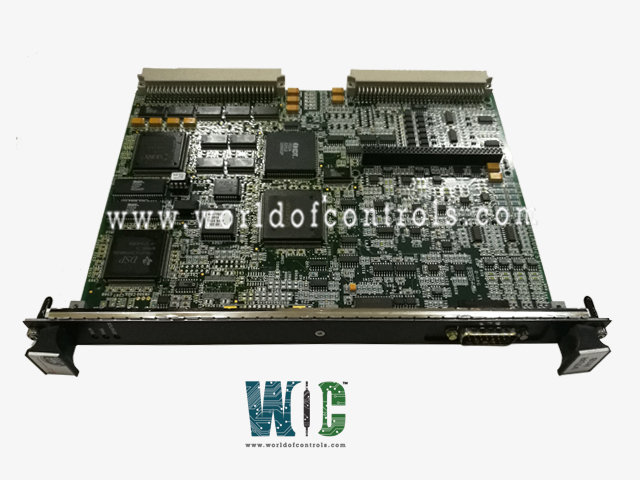
World Of Controls understands the criticality of your requirement and works towards reducing the lead time as much as possible.
IS200VTURH1BAB - Vibration Transducer Interface Module is available in stock which ships the same day.
IS200VTURH1BAB - Vibration Transducer Interface Module comes in UNUSED as well as REBUILT condition.
To avail our best deals for IS200VTURH1BAB - Vibration Transducer Interface Module, contact us and we will get back to you within 24 hours.
SPECIFICATIONS:
Part Number: IS200VTURH1BAB
Manufacturer: General Electric
Series: Mark VI
Product Type: Vibration Transducer Interface Module
Board rating: 125 V dc
Common Mode Voltage Range: ±5 V
Dimensions: 11.00 x 9.00 x 3.00
Operating temperature: 0 to 60 °C
No.of Analog Voltage Inputs: 6
Repair: 3-7 Day
Availability: In Stock
Country of Origin: United States
Manual: GEH-6421I
FUNCTIONAL DESCRIPTION:
IS200VTURH1BAB is a Vibration Transducer Interface Module manufactured and designed by General Electric as part of the VI Series used in GE Speedtronic Gas Turbine Control Systems. The system measures turbine speed using four passive pulse rate devices and relays the signal to the controller, which initiates the primary overspeed trip. It enables automatic generator synchronization and manages the closure of the main breaker. Additionally, it monitors induced shaft voltage and current, as well as eight Geiger-Mueller flame detectors used in gas turbine applications. These detectors are linked to the TRPG and operate on a 335 V DC, 0.5 mA supply from an external source.
The controller manages three primary overspeed trip relays located on the TRPG terminal board. When the trip signal is generated, it is transmitted to VTUR and subsequently to TRPG, triggering the emergency solenoids. Overspeed trips can originate from either VTUR or VPRO. The TRPG unit features nine magnetic relays for interfacing with three trip solenoids, referred to as Electrical Trip Devices (ETD). In Triple Modular Redundant (TMR) systems, nine relays are employed, while simplex systems utilize three.
OPERATION:
In a simplex application, turbine speed can be measured using up to four pulse rate signals. The generator and bus voltages are connected to VTUR for automatic synchronization, working alongside the turbine controller and excitation system. TTUR includes permissive generator synchronizing relays and manages the main breaker relay coil 52G. Shaft voltage is captured with brushes and monitored along with the current to the machine casing.
An interface supports four passive magnetic speed inputs with a frequency range of 2 to 20,000 Hz. With passive pickups on a sixty-tooth wheel, the circuit sensitivity enables the detection of a 2-RPM turning gear speed, allowing for the identification of turbine stoppage (zero speed). If the turbine control includes automatic turning gear engagement, this signal activates the turning gear operation.
PRIMARY TRIP SOLENOID INTERFACE:
The controller calculates the normal primary overspeed trip, which is then transmitted to VTUR and subsequently to the selected primary trip terminal board. TRPx contains relays that interface with the electrical trip devices (ETD) and usually operate alongside an emergency trip board (TREG), forming the primary and emergency interfaces to the ETDs. PTUR can support up to three ETDs powered by each TRPx/TREx combination, with various trip boards available through VTUR.
TRPG is designed for gas turbine applications and works in tandem with TREG for emergency trips. TRPS caters to small and medium steam turbine systems and is managed by the PTUR I/O pack, while TRPL is intended for large steam turbine systems, also controlled by the PTUR I/O pack for emergency scenarios. Additional trip boards are under development for specific applications. To facilitate trip board functionality, VTUR offers several discrete inputs to monitor signals, including trip relay positions, synchronizing relay coil activation, and ETD power status.
WOC has the largest stock of OEM replacement parts for GE Speedtronic Gas Turbine Control Systems. We can also repair your faulty boards and supply unused and rebuilt boards backed up with a warranty. Our team of experts is available round the clock to support your OEM needs. Our team of experts at WOC is happy to assist you with any of your automation requirements. For pricing and availability on parts and repairs, kindly contact our team by phone or email.
What is the purpose of the Vibration Transducer Interface Module?
The module interfaces with vibration transducers to monitor and analyze vibration levels in machinery, helping to ensure optimal performance and prevent equipment failure.
What types of vibration transducers are compatible with the module?
The module typically supports various transducer types, including accelerometers, velocity sensors, and displacement sensors.
How does the module process vibration signals?
It converts analog signals from the transducers into digital formats for analysis, enabling real-time monitoring and data logging.
What output options does the module provide?
The module usually offers various output formats, including analog, digital, and communication protocols such as Modbus or CAN bus.